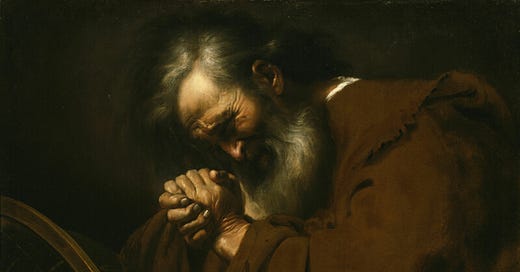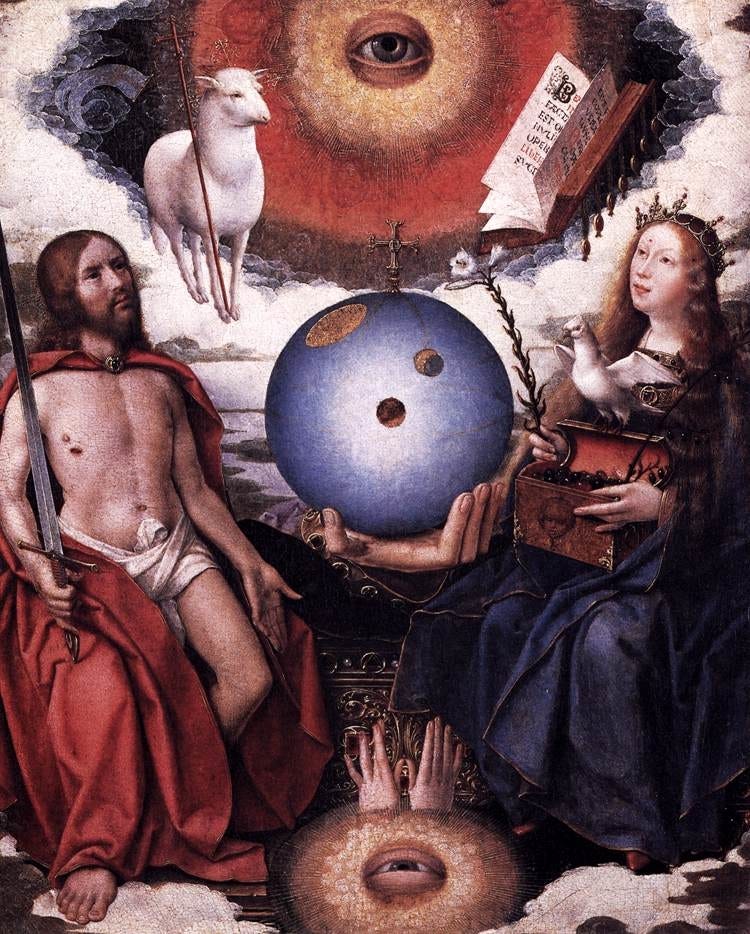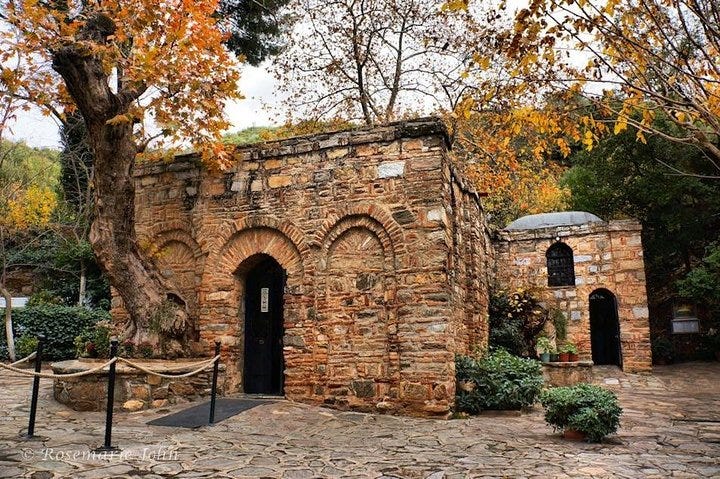The "Holy Trinity of Ephesus" is a conceptual framework created solely for this essay. It aims to provide a broad, philosophical perspective on our current human condition and our potential future trajectory.
As P. F. Sloan's 1964 hit, famously sung by Barry McGuire, proclaims, we are on the "Eve of Destruction." Sloan's foresight was ahead of his time by some sixty years. If you are unfamiliar with this powerful tune or wish to revisit it, here's the video.
This article explores three figures associated with the ancient Greek city of Ephesus, each crucial to our understanding of reality and the survival of our species.
Today, we are closer to nuclear holocaust than ever before, surpassing even the tensions of the 1962 Cuban Missile Crisis. The then nascent Military-Industrial Complex, which President Eisenhower warned about in his 1961 farewell address, was eager for conflict. Among its most hawkish members was Air Force General Curtis LeMay, a WWII hero and Chairman of the Joint Chiefs, who was particularly keen on war with Russia.
The placement of Russian nuclear weapons in Cuba was, to LeMay and the Kennedy administration, an intolerable provocation. Fortunately, President Kennedy managed to restrain the warmongers in his circle of advisors.
During the intense deliberations, LeMay famously declared, "Those goddamn Kennedys are gonna destroy this country if we don’t do something about this!"
America and its vassal states of NATO are once again on the brink of war with Russia. Since Kennedy’s assassination, the Military-Industrial Complex, which now includes the National Security State, has grown to dominate American foreign policy.
With Ukraine, NATO’s proxy puppet, now facing not only a humiliating military defeat but also the potential annihilation and dismemberment of the country, the war drums are beating loudly once more. Today, there are no great statesmen — no Roosevelts in America, no Churchills or DeGaulles in Europe. No one appears capable of restraining the warmongers.
What is their aim, you ask? Russia poses no clear and present danger to the U.S. or Europe. Russia simply objected to the West placing nuclear weapons on its Ukrainian doorstep in the same vein as America objected to Soviet missiles being placed in Cuba. Sauce for the goose.
Their Complex’s aim, in league with the E-U and the globalist elites is unipolar world hegemony; a New World Order (NWO). To that end, Russia indeed poses a significant threat — an existential threat to the Western hegemon. The NWO cabal is willing to sacrifice the greater portion of humanity, as many as 5-billion souls, to quench their insatiable thirst for power and control. I read just this morning that Google AI estimates 1-million Americans were killed by the ‘safe and effective’ Covid ‘vaccine.’1
The future of humanity lies in a multipolar world, a world of peace, not belligerence. We must avoid the planned next iteration of a unipolar world, which would be a totalitarian, slavish dystopia. President Kennedy articulates his vision for peace in this 48-second clip.
The road to a multipolar world need not be fraught with peril. However, we should be realistic about the lengths to which the global cabal will go to achieve their goals. Hoaxes like climate change and COVID, rigged elections, manufactured chaos, murder, and mayhem are in their toolbox. Nothing appears off limits as the ends justify the means.
Given that a peaceful transition to multipolarity is unlikely, our only hope is to remain optimistic in the face of earth-shattering change. I will present three brief vignettes about the Holy Trinity of Ephesus that will help guide us through these turbulent times.
Heraclitus, the Philosopher of Perpetual Change
Heraclitus was born in Ephesus in the 6th century B.C. He wrote one book, titled Nature, though only fragments of it survive. Despite this, he is considered by many to be one of the greatest philosophers who ever lived. He introduced the word and concept of the logos to Western philosophy and proposed that the world is in constant flux, a concept known as Panta Rhei (everything changes).
In Greek, logos translates to 'reason,' but signifies much more. The logos is a concept that explains reality and the underlying order of the universe. It represents a supreme truth that interconnects all things and drives all change. Some liken logos to God, but the logos is a monism that transcends the dichotomy of good vs. evil by encompassing both. In philosophy a monism represents the unity of all opposites.
During Heraclitus's time, the zeitgeist — or 'spirit of the times'— was one of intellectual ferment and reflective inquiry.
Heraclitus taught that the world exists as a coherent system, where changes in one direction are balanced by corresponding changes elsewhere. He described the world as "ever-living fire, kindling in measures and being extinguished in measures." This perspective fosters an acceptance of change rather than resistance. Many conceive of the logos as a metaphysical companion with whom they are in constant communication.
This communication with the logos is not merely a passive reflection but an active engagement. The logos serves as an inner guide, a source of wisdom that provides context and clarity to the path of life. It is a presence that offers insights, helping to navigate the complexities and uncertainties of existence. In moments of doubt or confusion, turning inward to converse with the logos provides a sense of grounding and purpose.
Engaging with the logos means tuning into the subtle, often intuitive signals that guide us towards harmony and balance. Jung called them ‘synchronicities.’ Artemis or Mary Theotokos might call them ‘graces.’ The signals are a dialogue that transcends words, encompassing feelings, thoughts and a deeper sense of knowing. This relationship with the logos nurtures our understanding of the interconnectedness of all things and our place within the cosmic order.
By viewing the logos as a companion, we acknowledge its role in shaping our consciousness and guiding our actions. It becomes a trusted ally in the quest for truth and self-awareness, encouraging us to embrace change and growth as natural and necessary aspects of life.
In contrast to Heraclitus’ era, the Western zeitgeist of today is marked by secularism and a mindset of 'Twitter inquiry'— characterized by simplistic views and narcissistic individualism. Social media has fostered a culture of magpies. Substacker
described the magpie as “someone who knows nothing yet manages to maintain a beautiful nest of ideas that aren’t theirs.”2Metaphorically, the magpie symbolizes an individual who skims the surface of the logos, prioritizing material gains, shallow communication and instant gratification. Intellectually, human magpies are cold, reminiscent of the Kafkaesque "frozen sea within," which can only be shattered by the axe of self-awareness and occasional engagement with a good book.
Conceptualizing the logos is no simple matter; analogies prove useful. If the cosmos, composed of many universes, is a cosmic symphony, the logos is its conductor, and the music is Plato’s ‘world soul,’ which animates the cosmos. Heraclitus saw the world as 'ever-living fire,' symbolizing underlying unity and perpetual, often dramatic change.
Soul is the vaporization out of which everything else is derived; moreover, it is the least corporeal of things and is in ceaseless flux, for the moving world can only be known by what is in motion.
Heraclitus fragment
The Spiritual Significance of Logos
The term logos is often translated simply as "word," yet its meaning in ancient Greek philosophy and Christian theology transcends this simplistic interpretation. For Heraclitus, the logos was not merely a spoken word or written text but a fundamental principle that underlies and governs the cosmos. It is a concept that embodies reason, order and the intrinsic connection between all things.
In the Christian tradition, the logos takes on an even more profound significance. The opening verses of the Gospel of John declare, "In the beginning was the Word, and the Word was with God, and the Word was God" (John 1:1). John the Theologian, as he is known in the Eastern church, identified logos with Christ, the divine agent through whom all things were created.
This Christian theological interpretation highlights the logos as both the creative force and the guiding light of the universe, encompassing both immanence and transcendence — the mystical force that unifies the human psyche with world soul.
Moreover, the logos is intimately linked to the concept of the divine spark within each human being. According to ancient philosophical and mystical traditions, every person carries within them a fragment of the logos, a seed of divine reason and potential. This inner logos is what enables humans to seek truth, aspire to higher understanding and align themselves with the greater order of the cosmos.
In Jungian psychology, this process of aligning with the logos is seen as the path of individuation, where a person integrates all aspects of their being and becomes whole. Jesus, as the embodiment of the logos, serves as the ultimate example of this process. His life and teachings illustrate how one can live in harmony with the divine order, fully actualizing the potential of the logos within.
Understanding the logos as more than just a word beckons a deeper exploration of our own nature and place in the universe. It challenges us to look beyond the superficial and the material, to seek the underlying truth that connects all things. In doing so, we honor the legacy of Heraclitus and the spiritual wisdom that has been passed down through the ages.3
Artemis, the (Reflective) Moon Goddess
Artemis is the Greek god Apollo’s twin sister, symbolizing the moon while her brother represents the sun. Artemis is also one of the three maiden goddesses of Mt. Olympus. The other two are Athena, the patroness of Athens, and Hestia, the patroness of hearth and home.
In Celtic mythos, these three would likely represent a Triple Goddess, highlighting the normative maiden, mother and crone motif. Within such a grouping, Artemis represents the quintessential maiden archetype. In Roman mythology, Artemis is known as Diana.
Most people associate the ancient Celts with Ireland and the British Isles. However, the Celts were Indo-Europeans originally from Anatolia (Asia Minor), the location of Ephesus. Celtic place names are found all over Europe. The River Danube was named after the Celtic Mother Goddess, Danu, and Paris was named for the Parisii Tribe, who first inhabited that area around 7600 B.C. Today’s Celts are the remnants of a once-great civilization, and we have much to learn from their mythology.
Similarly, we have much to learn from the ancient Greeks. Ephesus, in particular, is seen as the dwelling place of the Divine Feminine, who is presently in exile from Safed, the highest city in Galilee. There’s a point to these digressions: we Westerners have been prescribed a very narrow view of reality. Otherwise, perhaps we could not be so easily deceived and manipulated.
If only we could pull back to a vantage point on Mount Olympus or learn a lesson from the ruins of Göbekli Tepe, which is located in Anatolia. Göbekli Tepe was home to the world’s first temple, constructed around the end of the last Ice Age some 12,000 years ago.4
If only we could reflect on the mysteries of existence such as the goddess Artemis, a symbol of both celestial and earthly forces. Her great temple at Ephesus, in the words of poet Antipater of Sidon, “surpassed even the grandeur of Babylon’s walls and the pyramids.” The Temple of Artemis was built around 550 B.C.E.
Artemis is the patron of childbirth. Given the alarming depopulation agenda and the negative effects of the vaccine on fertility, I imagine Artemis/Diana and Mary Theotokos are destined to play a decisive role in thwarting the globalists’ dream of world domination.
Mary Theotokos
At the Council of Ephesus in AD 431, leaders of the relatively new Christian religion met to settle an argument. Mary, like Artemis, personifies the maiden archetype, an aspect of the Divine Feminine. The debate centered on the question of whether Mary was the ‘mother of God’ or the ‘mother of the Christ.’ This was no small point and many believe they got it wrong.
Theotokos in Greek means 'God bearer' and can be correctly applied to either interpretation. In the Council's disputations, the members asserted that Mary gave birth to God. In my humble opinion, she gave birth to Jesus, who then became the Christos (Greek for 'anointed one'). The truth is that Jesus never claimed to be God, nor did Jews believe that their messiah would be divine.
We should understand that John’s gospel, which espouses Jesus as God, is theology rather than a historical recounting of Jesus's life, as depicted in all three synoptic (seeing with the same eyes) gospels of Matthew, Mark and Luke.
The synoptic gospels recount the sayings of Jesus within the context of his earthly ministry. They are primarily based on the same source, known only as ‘Q’ (from the German quelle, meaning 'source'). No first-century Jew in his right mind would have said some of the things John attributed to Jesus in order to delineate his theology.
In Jungian terminology, Jesus 'individuated' and became one with God, something we all can aspire to and something we all are theoretically capable of. Every human is born with a divine spark, an implant of the divine logos. While we might fall short of Christhood, we can aspire to emulate the life of Jesus. We humans are both ‘in the world’ and 'of the world.' Jesus was the former but not the latter, by his own free will and grace of logos.
John, who by the way was also from Ephesus, had Jesus pray for each and every one of us in these words:
Sanctify them by the truth. Your word is truth. Just as you sent me into the world, so I have sent them into the world. It is for their sakes that I sanctify myself, so that they, too, may be sanctified by the truth. I ask not only on behalf of these men [his disciples], but also on behalf of those who will believe in me through their message, so that they may all be one. Just as you, Father, are in me and I am in you, may they also be one in us, so that the world may believe that you sent me.
John 17:17-21
Mary Theotokos, Mary the Mother of Jesus, spent her final years at Ephesus in the care of St. Luke, who was a physician. This is truth, not only by virtue of tradition, but also by virtue of reality. Today, Mary's home in Ephesus is venerated, as is she personally. Mary is not worshipped, as many who fail to grasp the nuance often claim. She is venerated.
The Eastern Church is considered by many to have elevated the veneration of Mary to the highest level, which is her proper spiritual abode. I wrote about the Eastern Church’s iconic and unparalleled devotion to Mary in “Softener of Evil Hearts” here.
In the West, veneration of Mary is present in Roman Catholicism and its close offshoots. Christianity — the religion, not the spirituality — has sadly become a cult of Jesus, to varying degree. Spiritual Christianity, in my humble opinion, assumes a more gnostic, mystical approach.
Spiritual Christians are still seekers, not knowers, of truth. In the spiritual quest for truth and understanding, gnostics make greater room for Mary and Mary Magdalene, who was recognized by the church as the “Apostle to the Apostles,” as well as the many other women who were important to Jesus’ ministry.
Today, in the tiny village of Medjugorje, in the former Yugoslavia, Mary Theotokos speaks to us through apparitions of her disembodied consciousness or Mind. She communicates through six gifted visionaries, who are all now grown but were children when she first appeared to them in 1981. The Medjugorje apparitions have been ongoing at least weekly ever since.
Mary told one of the children that "World War 3 will not occur." This, I suppose, could be interpreted as either a blessing or a curse. A catastrophe such as nuclear armageddon need not result from another world war, nor would a devastating natural calamity such as the one that destroyed the advanced civilization that built Göbekli Tepe.
She told the visionaries that, at the 'proper time,' she will allow the secret prophecies she has shared with them to be revealed to the world. Her promise seems to echo the biblical call to the multitudes to gather in the Valley of Jehoshaphat — the Valley of Decision — where the Lord will make himself known to all nations (Joel 3:14).
The revelation of these secrets assumes the Vatican does not censor her, as it did with the apparitions at Fatima. I will publish the secrets on these pages.
Today, Mary’s former home is a destination for Christians and Muslims, who also venerate her. “O Mary, indeed Allah has chosen you and purified you and chosen you above the women of the worlds” (Quran 3:42). Outside her house, there is a "wish wall," on which pilgrims and tourists alike hang papers or pieces of cloth recording their sincere wishes and petitions. A nearby fountain is said to have the power to cure illness or grant women the ability to become mothers.
The 'pieces of cloth' are called clooties, an ancient Celtic tradition. I once lived in Cornwall, England, which was a Celtic country before becoming an English county. On my walks, I often spotted clooties hanging from the thorny branches of hawthorn trees near Cornwall’s ubiquitous Holy Wells.
“Ervin László's 2004 book, Science and the Akashic Field: An Integral Theory of Everything, posits a field of information as the substance of the cosmos. Using the Sanskrit and Vedic term for ‘space,’ Akasha, he calls this information field the ‘Akashic field.’ He posits that the ‘quantum vacuum’ [once called the aether] is the fundamental energy and information-carrying field that informs not just the current universe, but all universes past and present.” (source)









